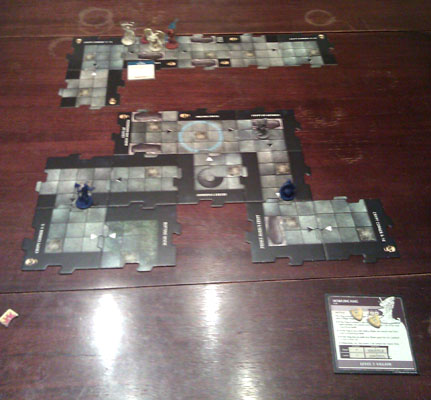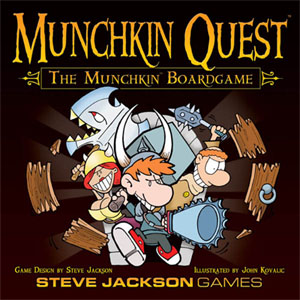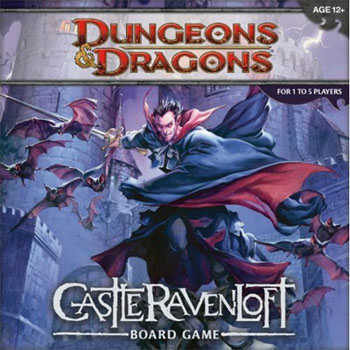 A couple days ago I posted my first thoughts on the Castle Ravenloft boardgame. One of the things I mentioned was the horrific quality of the rulebook. Today I want to expound upon that a little bit.
A couple days ago I posted my first thoughts on the Castle Ravenloft boardgame. One of the things I mentioned was the horrific quality of the rulebook. Today I want to expound upon that a little bit.
But first, let me mention how the session we played last night went: We had a couple of newbies at the table, so we started with Adventure 2: Find the Icon of Ravenloft. This is essentially the plain, vanilla version of the game. It’s a good way to get introduced to the basic gameplay, and then wraps up with a climactic fight in the Chapel. We were able to conserve our big AoE attacks until reaching the Chapel, but then two bad Encounter draws ended up teleporting two of our Heroes to opposite ends of the dungeon while spawning even more monsters. With a good deal of scrambling, however, we were able to strand a gargoyle, reconcentrate the enemies, and then blast our way out of the castle.
Good times.
We then moved to Adventure 9: Gauntlet of Terror. In this scenario the layout of the dungeon is largely predetermined at the beginning of play and groups of monsters are moving towards the dungeon’s entrance, seeking to escape and ransack the village. This adventure completely inverts the strategy of the game in almost every way.
The first time we played it, we screwed up the respawning rules for the monsters. Then a couple of players left and a new player showed up and we played through it a second time using all of the rules correctly. Both plays were great fun, with quite a few really tense moments. (Including one memorable turn where we ended up semi-intentionally spawning 7 monsters at the same time.)
I’ve now played the game a total of 18 times. It continues to deliver a consistently fun experience.
THE RULEBOOK
With that being said, I now want to discuss the inadequacies of the rulebook in a bit more detail. To quickly sum up the problem: Castle Ravenloft pretty much can’t be played without house-ruling nearly every facet of the game.
EXAMPLE 1: IMMOBILIZATION
The complete rules for the Immobilized condition read: “If your Hero is Immobilized, your Speed is reduced to 0 — you can’t move!”
Okay, that means that you can’t use a Move action to move (since your Speed has been reduced to 0). But can you still use At-Will, Utility, or Daily powers that allow you to move? What if another character uses a power that would move you… is that allowed? What if an encounter card is triggered with a trap-like effect that would ordinarily force you to move — does the Immobilized condition prevent that movement, too? What if the effect in question doesn’t use the word “move” to describe the positional change, should that be allowed?
For example, here’s the text from the Overwhelming Terror encounter card: “Place each Hero 2 tiles closer to the Start tile. If a Hero is on the same tile as a Monster after being placed, that Hero is slowed.”
Should Overwhelming Terror move an Immobilized Hero to a new tile? Does the flavor text (“A cacophony of shrieks and howls rises up around you, and you flee in terror.“) change your opinion?
If they aren’t moved, do you still check to see if they are slowed? And if you do, do you use the tile they’re currently on or the tile they would have been placed on if they were moved?
Okay, let’s consider Strahd’s Minions: “Place the active Hero and the two Monsters that are closest to that Hero on the tile farthest from the active Hero. If there are less than two Monsters in play, place a new Monster adjacent to the active Hero after he or she is placed.”
If an Immobilized Hero isn’t placed on a new tile, should you still move the monsters? And if not, should you draw a new monster if there are less than two in play? (After all, there is no “after he or she is placed” if the Hero was never placed.)
Should an immobilized rogue be allowed to move as part of their Deft Strike ability? (“Before the attack, you can move 2 squares. Attack one adjacent Monster.”) If not, should the immobilized rogue be allowed to move when the cleric uses Hallowed Advance? (“Hit or miss, each other Hero can move one tile.”) If not, can the fighter use Bodyguard when the immobilized rogue is attacked? (“The attack misses instead, and you swap positions with the Hero that was attacked.”) Can the fighter use Bodyguard if the fighter is the one who’s been immobilized?
In order to have a nice, consistent ruling for being immobilized, our table has been playing “Immobilized” to mean:
(1) The immobilized Hero cannot change their own location through the use of any action or power. Any other power, ability, or effect which would change the immobilized Hero’s location takes effect normally — including other Heroes using their powers, attacks from Villains and Monsters, and Encounter cards.
But other reasonable interpretations could include:
(2) “Immobilized” simply reduces the Hero’s speed to 0. Any effect (including their own powers) which allows a Hero to move without taking a Move action can be performed normally.
(3) An immobilized Hero “cannot move”. Nothing will cause them to leave they’re currently standing in.
(4) 4th Edition’s definition of Immobilized: “You can’t move from your space, although you can teleport and can be forced to move by a pull, a push, or a slide.”
Since forced movement isn’t defined as part of the Castle Ravenloft rules (and “pull, “push”, and “slide” are terms of art which are not used), this would still leave gray areas. But you could try to formalize something close to it by saying:
(5) An immobilized Hero has a speed of 0 and cannot move using a Move action. A Hero cannot use any of their own abilities to move. (Exception: The eladrin’s Fey Step ability can be used normally.) Any ability or effect which says that a Hero “may” or “can” change their position cannot be used by the Hero. Abilities or effects which do not give the Hero a choice in whether or not to move affect an immobilized Hero normally.
Of course, each of these variant interpretations result in significantly different gameplay. And many of them don’t provide clear guidance in resolving the tack-on issues of effects like Strahd’s Minions. (One of the reasons we use the interpretation we do is because it doesn’t have any gray areas in resolving abilities or powers found in the game. It may occasionally give “illogical” results based on the flavor text, but it can be applied with absolute consistency.)
EXAMPLE 2: GAUNTLET OF TERROR
Adventure 9: Gauntlet of Terror, like most of the adventures in the game, introduces several scenario-specific rules. For example:
When an active Hero moves within 1 tile of a tile with a face-down Monster token on it, or onto a tile with a face-down Monster token on it, flip that token over.
Seems simple enough. But does that mean that a Hero can avoid flipping Monster tokens by simply not moving on their turn? And if that’s the case, then we’ve also re-opened the whole “what counts as a move?” can of worms. Are we only talking about Move actions? What if you take a Move action (which may or may not be mandated by the game) but move 0 spaces? Or use your Move action to do something other than move? What if you’re immobilized?
And so forth.
(We interpreted this rule as, “If the active Hero is within 1 tile of a face-down Monster token or on the same tile as a Monster token at any point during their Hero phase, flip that token over.”
This seems to match the intention of the rule as written, but may be a distortion if “move” should be interpreted to include movement from Encounter cards (which are drawn after the active player’s Hero phase is completed). On the other hand, if we changed the rule to read “if the active Hero is within 1 tile of a face-down Monster token (…) at any point during their turn” we end up with a different kind of distortion because the Monster tokens can also be moved within range during their turn but after the Hero has moved. The rules as written clearly don’t suggest those tokens should be flipped over… but maybe they should? I don’t know.)
Complicating this, here’s another example from the same scenario:
Discard the token [you flipped over]. Then place a new Monster token from the box top face down on any tile (except for the Start tile) that doesn’t have a Monster token on it.
Does that mean we can place a Monster token on the same tile as the Monster token we just flipped over? And, if so, should we immediately flip it over again?
Another point of confusion: The rule as written reads, “When an active Hero moves within 1 tile (…) or onto a tile.” That’s a strange way of writing it because “within 1 tile” is interpreted consistently elsewhere in the game to include the tile you’re on. It’s probably just needless redundancy, but should it be interpreted to mean that “within 1 tile” doesn’t include “the tile the Monster token is on” in this particular case? If so, does that mean if you start your turn on a tile with a Monster token on it that you can actually move around on that tile without flipping the token over (since you wouldn’t be moving onto the tile)? Or even move diagonally off the tile (which would result in you being two tiles away and never “within 1 tile” due to the tile-counting rules)?
Final example:
Shuffle the Dungeon Tile stack and take out 15 tiles. One at a time, each player takes a turn placing one of those tiles adjacent to the unexplored edge that it closest to the Start tile until all 15 tiles have been placed.
This rule is problematic because it doesn’t tell you how to orient the tiles you’re placing. Since the monsters and monster tokens in the scenario follow the arrows on the tiles, the vagueness of the rule technically allows the players to construct a board in which all of the monsters move away from the Start tile (making the scenario ridicuously easy).
THE NEED FOR A REVISED RULEBOOK
Needless to say, these radically different interpretations and/or patchings of the rulebook are not trivial matters in terms of gameplay.
For example, if Monster tokens can be placed on the same tile you just removed a Monster token from and they can be triggered as you place them, you can actually end up in scenarios where all the remaining monsters in the game spontaneously generate.
On the other hand, consider the difference between (1) “characters moving as a result of encounter cards flip a monster token” and (2) “characters only flip monster tokens while using a Move action” when dealing with an encounter card like Strahd’s Minions (“Place the active Hero and the two Monsters that are closest to that Hero on the tile farthest from the active Hero. If there are less than two Monsters in play, place a new Monster adjacent to the active Hero after he or she is placed.”).
In the first scenario, you end up with a situation where a Hero can be teleported to the far side of the board and immediately spawn multiple monster tokens which will (probably) all attack them simultaneously on the same turn.
In the second scenario, however, the Hero is stranded in a far corner of the dungeon surrounded by prowling monsters, allowing the other players to move the monster tokens away from their location and prevent the mass-spawning which would otherwise occur on their next turn.
Off-hand, I can’t tell you which one makes for the more interesting game; nor can I tell you which one makes for a more balanced game; nor can I tell you which one the designers (Mike Mearls and Peter Lee) intended me to play.
And these are not isolated problems. Both the Rulebook and the Adventure Book are filled to the brim with this kind of vagueness and inaccuracy. I can’t really classify this as bad game design (I’m pretty certain the underlying design is actually quite robust and thoroughly playtested). It’s atrocious rules-writing, not bad rules-design.
But given this woeful shortcoming in the game, it’s surprising that Wizard’s response to the problem has been an overwhelming and deafening silence: No errata. No FAQ. No official clarification or support of any kind.
So, to conclude: Fun game. Very much worth grabbing a copy of. But be prepared to put in a little sweat equity to make the game function properly.
Go to Castle Ravenloft: More Rulebook Woes
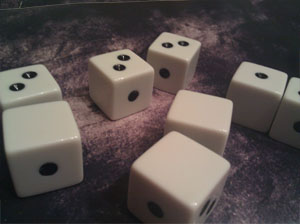 For Christmas I got a copy of Betrayal at House on the Hill. It’s a great little game. I don’t really have much to say about it at the moment, but I bring it up because the game ships with eight 6-sided dice which are marked as 1d3-1 (generating results of 0, 1, or 2 pips). At one point during the holidays we had the game half set-up when everyone got distracted by some other bit of family business, which left a couple of people mucking about with the dice.
For Christmas I got a copy of Betrayal at House on the Hill. It’s a great little game. I don’t really have much to say about it at the moment, but I bring it up because the game ships with eight 6-sided dice which are marked as 1d3-1 (generating results of 0, 1, or 2 pips). At one point during the holidays we had the game half set-up when everyone got distracted by some other bit of family business, which left a couple of people mucking about with the dice.

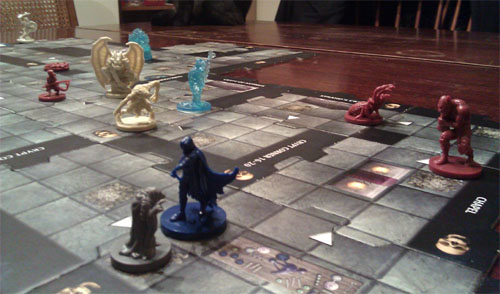
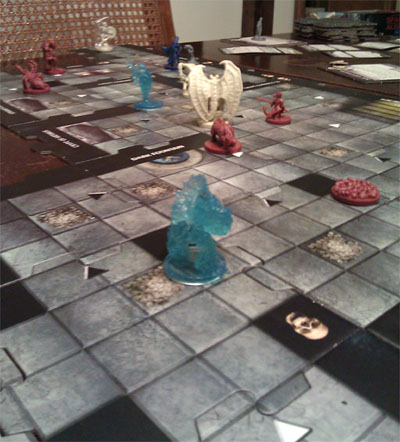
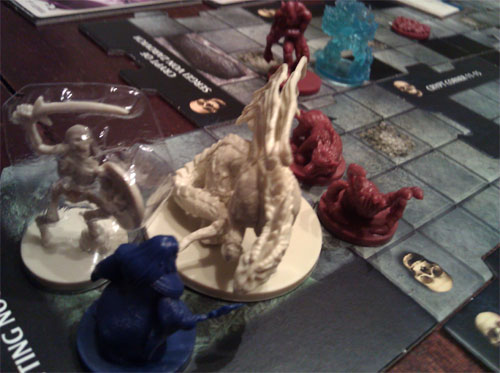
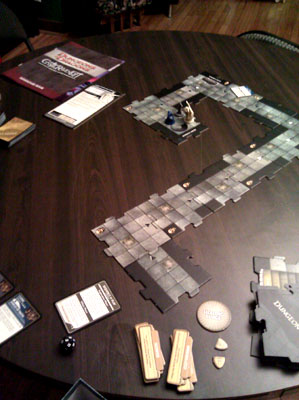 So while the game is more variable and interesting than dungeon-crawlers featuring pre-determined dungeon layouts, there’s also no sense of actually exploring the dungeon in most of the scenarios.
So while the game is more variable and interesting than dungeon-crawlers featuring pre-determined dungeon layouts, there’s also no sense of actually exploring the dungeon in most of the scenarios.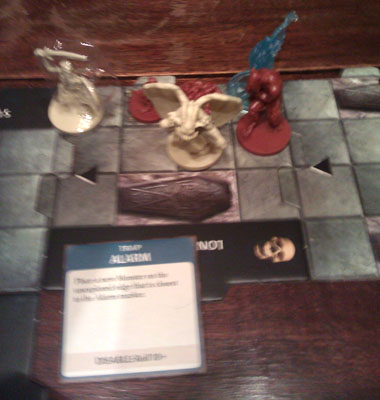 This is not, strictly speaking, true: Castle Ravenloft does have tactical depth; it’s just a tactical depth that looks absolutely nothing like 4th Edition’s tactics.
This is not, strictly speaking, true: Castle Ravenloft does have tactical depth; it’s just a tactical depth that looks absolutely nothing like 4th Edition’s tactics.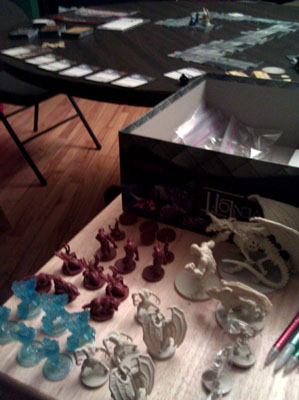 The argument could certainly be made that it’s worth buying the game just for the 42 miniatures that come with it. I don’t think I’d disagree: Amazon is selling the game for $50 right now, so the price per mini comes out to about $1.20. Since that includes a Huge Dracolich, I’m pretty happy with it. (And that’s ignoring the general utility of the interlocking dungeon tiles.)
The argument could certainly be made that it’s worth buying the game just for the 42 miniatures that come with it. I don’t think I’d disagree: Amazon is selling the game for $50 right now, so the price per mini comes out to about $1.20. Since that includes a Huge Dracolich, I’m pretty happy with it. (And that’s ignoring the general utility of the interlocking dungeon tiles.)